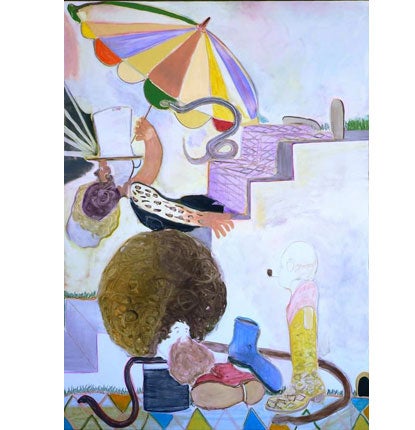Jerwood Contemporary Painters, Jerwood Space, London

Your support helps us to tell the story
From reproductive rights to climate change to Big Tech, The Independent is on the ground when the story is developing. Whether it's investigating the financials of Elon Musk's pro-Trump PAC or producing our latest documentary, 'The A Word', which shines a light on the American women fighting for reproductive rights, we know how important it is to parse out the facts from the messaging.
At such a critical moment in US history, we need reporters on the ground. Your donation allows us to keep sending journalists to speak to both sides of the story.
The Independent is trusted by Americans across the entire political spectrum. And unlike many other quality news outlets, we choose not to lock Americans out of our reporting and analysis with paywalls. We believe quality journalism should be available to everyone, paid for by those who can afford it.
Your support makes all the difference.Who are the best young painters at work today? This group show of about 30 works is the choice of the Jerwood's three judges, who are all practising artists themselves. Very few of these 26 young people is fresh out of college; they are not really, in that strange, queasiness-inducing locution, emerging. Quite a few of them are well established, and already represented by first-rate galleries.
Take Ryan Mosley, for example, who two years ago had just graduated from the Royal College of Art, and was chosen by this newspaper as the talent to watch out for in 2008. His large canvas in this show, Psycho Cubist Picnic, is a kind of surrealist-cum-cubist-cum- Gustonish act of zany, venturesome play with figures and things – or rather parts of figures and things. All the bits of the world seem to be falling and spinning apart in hilariously comic style. It seems to have been painted in a kind of wild, Picasso-like dash, and it's full of a tremendous sense of vim and gusto.
And that, in fact, is the overall tone of this show – a kind of reckless, experimental joy in the use of paint on canvas, a rooted belief that the world is the painter's oyster, and that if you should happen to choose to gild and prettify that oyster these days, it's entirely your prerogative. There's nothing hole-in-corner about any of this work, no feeling that the art of painting itself might be beleaguered, or under some kind of a threat from the newer media. It's all very self-confident stuff; it's work that often connects up stylistically with the recent and even the distant past (look at Matthew Weir's fascinating take on an Adam Elsheimer, for example), but it is also forging ahead into the future without any flinching or hesitation.
And when it does pay homage to the past, it often does so playfully. The past is there for the joyous plundering. The past is there to give a kind of density, a kind of layering, to the present. It is playful and confident, seldom over-earnest, always unconstrained. There is no evidence of any particular school or tendency, no dominating trend, no particular look-at-me brashness. Instead, a kind of wilful eclecticism seems to be the order of the day. There's a steady commitment to the idea of the importance of the art of painting. But most of all, the show seems to be shouting back at us: "Who can do it better than a painting?" Painting is just as young and vibrant as it is old and venerated. In short, it's here to stay – and, by the way, it always has been.
Is the work predominantly figurative or abstract? A variable mixture of the two. Much of the best work is abstract, but it does not have the severity of the pioneers of abstraction. It does not set out to prove that abstraction represents a kind of unassailable purity of vision, something which is set apart from the mess and the muck of the world. This is an abstraction which is often within a jokey nodding distance of recognisability.
Here, for example, is a piece by Sam Windett which looks, with its geometrical severity, like a take on Constructivism. But it's only partially that. There's too much cheekily understated colour washing about the work. What is more, the title gives the game away: Mobile (white). And this is often the case with the abstract work in this show. Colour gets poured in to lighten up a mood – there's none of the priestly poker-facedness of Abstract Expressionism about this confidently cheerful gang. Some of the figurative work has a beautifully delicate tonal simplicity, a paring back to the essentials – look at David Webb's representation of a Monarch butterfly, what he has made of the form, and how he has contextualized it within its painterly environment. It's all very simple, beautifully judged and poised – just like a fecklessly evanescent butterfly, in fact.
Join our commenting forum
Join thought-provoking conversations, follow other Independent readers and see their replies
Comments